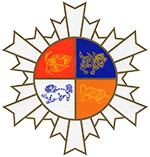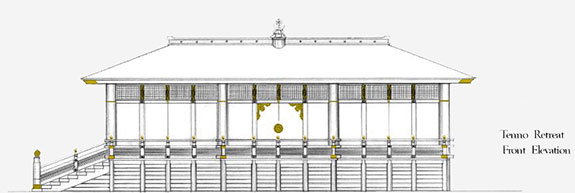While lunching in Cheticamp, on the northwestern coast of Cape Breton Island, the Druk Sakyong relayed to his travel companions that he sensed the presence of a significant place for Shambhala nearby. He indicated that it might lie somewhere across the expanse of the interior Cape Breton Highlands. Later that afternoon the Druk Sakyong directed the cars of his motorcade to pull off the road in front of a locked entrance to a secluded private property. The valley behind the locked gate was situated where the Ingonish River flows into a protected cove of the Atlantic Ocean. Standing by the cars and unable to proceed into the valley, the Druk Sakyong told his amazed students that this was Kalapa, the capital of Shambhala. That was in 1979, during the Druk Sakyong’s second Nova Scotia exploratory visit. The hidden valley is now known as Kalapa Valley.

The following year, the Druk Sakyong returned to Kalapa Valley accompanied by the future Sakyong, Mipham Rinpoche and a small party of students. Although the winter conditions were harsh and they were only able to reach a field just inside the land’s boundary by the river’s edge, these intrepid pioneers were there to conduct a lhasang (blessing ceremony). The Druk Sakyong, joyfully smiling in the windblown freezing rain during the lhasang, pointed into the depths of the valley and said simply, “Kalapa.”
Auspiciously, this property became available for sale in 1993. With the encouragement of the Sakyong, Mipham Rinpoche five Shambhala members purchased the land to hold in stewardship. Throughout the 90’s, the Sakyong visited the valley a number of times, performing lhasangs and overseeing the burial of two treasure vases from Dilgo Khyentse Rinpoche. The ashes of the Druk Sakyong were scattered on the land. In 1995 the Sakyong declared Kalapa Valley a Shambhala sacred park and pilgrimage site. He selected sites for six large Ashe-inscribed Protection Posts that were subsequently installed around the property.
In 1993, the land stewards, led by Steve Brooks, completed arrangements to donate the Kalapa Valley to Shambhala. Before the valley changed hands, the Sakyong wrote:
“While the capital is in Halifax, the secret heart centre is in Kalapa Valley…. Its energy is essential to propagating Shambhala. We are enthusiastic. The Valley is the place of Shiwa Ökar, a place to practice the Werma Sadhana…. We should raise the Shambhala flag and the Sakyong’s flag to proclaim the lineage of the Sakyongs, and have a flag made with the Shambhala Anthem calligraphed on it. There should be a procession and formal raising of these flags with honour.”
This was accomplished under a vivid blue sky on October 11, 2003.
Soon, students supplicated the Sakyong to undertake the Scorpion Seal meditation retreat practice at the Kalapa Valley. This retreat practice is described by the Druk Sakyong in the Scorpion Seal of the Golden Sun root text, which is the basis of the Werma Sadhana.
Sakyong Mipham said he would undertake the retreat once a dedicated retreat structure was designed and built. Gina Stick was chosen as the project architect. The principles and energies that guided her design are indicated in her writings:
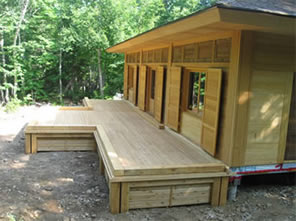 The Sakyong’s Retreat is a marriage of k’an-yu or feng shui with a Shambhala inspired sacred architecture. The building was strategically designed to gather and focus the land potential of the valley into the retreat building. Sacred architecture derives much of its power from the surrounding landform, accessed through strategic site selection and placement, and building design.
The Sakyong’s Retreat is a marriage of k’an-yu or feng shui with a Shambhala inspired sacred architecture. The building was strategically designed to gather and focus the land potential of the valley into the retreat building. Sacred architecture derives much of its power from the surrounding landform, accessed through strategic site selection and placement, and building design.
The imagery of the Druk Sakyong’s Great Eastern Sun talks suggest a protocol for the throne of the King and also the posture from which practitioners can awaken to their innate imperial nature. Symbolically, perceptually and magically, this seat is the center of an enlightened kingdom. …The Sakyong is the Kingdom’s lightning rod, the central pillar joining heaven and earth by his presence – setting in motion the drala energy of the Valley and the Kingdom.
The site for the cabin is in a forest more than a kilometer within the Kalapa Valley. The remoteness of the building site has consistently challenged the construction process. It is far off the power grid and a brook that sometimes surges in water level must be traversed. Nevertheless, wonderful progress was made on the building.
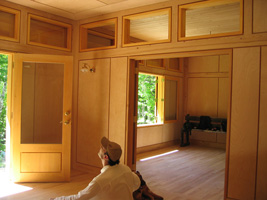 The construction on the Scorpion Seal Retreat Cabin continued during the summer months of 2005. Although it was only roughly finished, the Sakyong was able to enter into and complete the final segment of the Scorpion Seal practice there. During this retreat, the Rigden Abhisheka fully arose to the Sakyong. He remarked that the Scorpion Seal Retreat Cabin, although unfinished, is the first truly Shambhalian building.
The construction on the Scorpion Seal Retreat Cabin continued during the summer months of 2005. Although it was only roughly finished, the Sakyong was able to enter into and complete the final segment of the Scorpion Seal practice there. During this retreat, the Rigden Abhisheka fully arose to the Sakyong. He remarked that the Scorpion Seal Retreat Cabin, although unfinished, is the first truly Shambhalian building.
After the Sakyong’s retreat, work on the building went into a several year hiatus. Now construction is actively undertaken each summer in accord with the amount of funds donated to the project. The refined wooden interior design of Architectural Interiors Consultant, Bob Rader, is now substantially built-out.
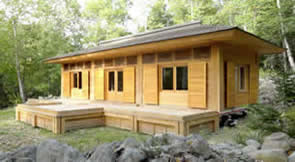 The exterior has been handsomely sided in white pine and a cedar veranda extends along the entire front of the building. Yet final work remains on both the interior and the exterior to complete the sacred architectural vision. The grounds remain a rough construction site detracting from the overall beauty and lungta. The Sakyong has provided clear guidance on how this area could be transformed into a sacred site, attractive to the dralas. He has indicated a large lhasang area, entry gates, approach paths (including a light vehicle bridge over Peddler’s Brook) and the opening of views into the inner Kalapa Valley. It is intended for the building to be crowned with a specially cast metal adornment.
The exterior has been handsomely sided in white pine and a cedar veranda extends along the entire front of the building. Yet final work remains on both the interior and the exterior to complete the sacred architectural vision. The grounds remain a rough construction site detracting from the overall beauty and lungta. The Sakyong has provided clear guidance on how this area could be transformed into a sacred site, attractive to the dralas. He has indicated a large lhasang area, entry gates, approach paths (including a light vehicle bridge over Peddler’s Brook) and the opening of views into the inner Kalapa Valley. It is intended for the building to be crowned with a specially cast metal adornment.
The Sakyong returns regularly to the Kalapa Valley for meditative and writing retreats. Over the last few years, he has stayed with his staff in the modest yet comfortable main house. Yet, the Sakyong has expressed his intention to inhabit the Scorpion Seal Retreat Cabin for meditation and on-site ceremonies with his senior students when the cabin construction is complete.
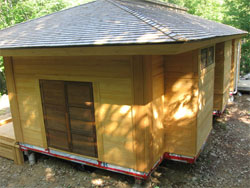 The Sakyong has said that the Kalapa Valley is where he is able to make deep connection with the wisdom of the Rigdens and the Mother and Father Lineages. It is a primordial spring that nourishes the manifestation of Shambhala worldwide.
The Sakyong has said that the Kalapa Valley is where he is able to make deep connection with the wisdom of the Rigdens and the Mother and Father Lineages. It is a primordial spring that nourishes the manifestation of Shambhala worldwide.
The Sakyong’s Scorpion Seal Retreat Cabin is the principle meditation seat of the Lineage of Sakyongs. The Scorpion Seal path is the essential expression of the Sakyong, Mipham Rinpoche’s transmission of the Druk Sakyong’s terma. At this auspicious juncture, we want to carry this project to elegant completion so that the Sakyong may properly continue to enter Scorpion Seal Retreat.
We hope that you, wherever you are in Shambhala, will be inspired to generously donate an offering to make it so. The White Ashe Pin is offered to donors of $108 or greater.
